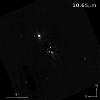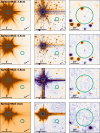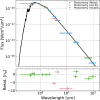A temperate super-Jupiter imaged with JWST in the mid-infrared
- PMID: 39048015
- PMCID: PMC11424479
- DOI: 10.1038/s41586-024-07837-8
A temperate super-Jupiter imaged with JWST in the mid-infrared
Abstract
Of the approximately 25 directly imaged planets to date, all are younger than 500 Myr, and all but six are younger than 100 Myr (ref. 1). Eps Ind A (HD209100, HIP108870) is a K5V star of roughly solar age (recently derived as 3.7-5.7 Gyr (ref. 2) and Gyr (ref. 3)). A long-term radial-velocity trend4,5 and an astrometric acceleration6,7 led to claims of a giant planet2,8,9 orbiting the nearby star (3.6384 ± 0.0013 pc; ref. 10). Here we report JWST coronagraphic images which reveal a giant exoplanet that is consistent with these radial and astrometric measurements but inconsistent with the previously claimed planet properties. The new planet has a temperature of approximately 275 K and is remarkably bright at 10.65 and 15.50 µm. Non-detections between 3.5 and 5.0 µm indicate an unknown opacity source in the atmosphere, possibly suggesting a high-metallicity, high carbon-to-oxygen ratio planet. The best-fitting temperature of the planet is consistent with theoretical thermal evolution models, which were previously untested at this temperature range. The data indicate that this is probably the only giant planet in the system, and therefore we refer to it as b, despite it having significantly different orbital properties than the previously claimed planet b.
© 2024. The Author(s).
Conflict of interest statement
The authors declare no competing interests.
Figures











References
-
- NASA Exoplanet Archive. IPAChttps://exoplanetarchive.ipac.caltech.edu/ (accessed 22 June 2024).
-
- Feng, F. et al. Detection of the nearest Jupiter analogue in radial velocity and astrometry data. Mon. Not. R. Astron. Soc.490, 5002–5016 (2019).
-
- Chen, M. et al. Precise dynamical masses of Eps Indi Ba and Bb: evidence of slowed cooling at the L/T transition. Astron. J.163, 288 (2022).
-
- Endl, M. et al. The planet search program at the ESO coudé echelle spectrometer. III. The complete long camera survey results. Astron. Astrophys.392, 671–690 (2002).
-
- Zechmeister, M. et al. The planet search programme at the ESO CES and HARPS. IV. The search for Jupiter analogues around solar-like stars. Astron. Astrophys.552, A78 (2013).
LinkOut - more resources
Full Text Sources

